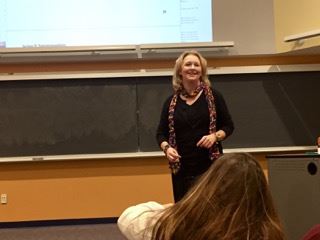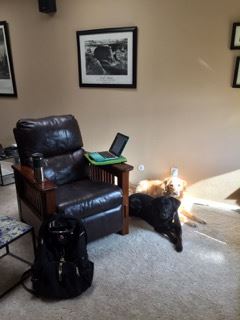 School name: New Mexico State University
School name: New Mexico State University
Type of school: Doctoral-granting, Hispanic Serving Institution
School locale: Las Cruces, NM, a medium size city in southern New Mexico in the shadow of the Organ Mountains
Classes you teach: Introduction to Psychology (undergrad), Human Sexuality (undergrad), Teaching of Psychology (grad)
Average class size: In a typical semester, I teach two sections of Introduction to Psychology, each enrolling 140 students. I occasionally teach Human Sexuality with 80 students, and a graduate course in Teaching of Psychology with six students.
What’s the best advice about teaching you’ve ever received?
Practice backwards course design:
- Decide what you want students to be able to do (not know, understand, or appreciate) by the end of the course
- List the knowledge and skills students will need to be able to do those things
- Determine what students need do (in class and outside of class) in order to develop that knowledge and those skills
- Figure out what you can do (in class and outside of class) to help students develop that knowledge and those skills.
With backwards course design, course alignment and other best practices in teaching and assessment are very straightforward (for more detail see Creating Significant Learning Experiences: An Integrated Approach to Designing College Courses, 2nd Ed by L. Dee Fink, 2013).
What book or article has shaped your work as a psychology teacher?
My teaching is a product of Ken Bain, Larry Michaelsen, and L. Dee Fink, run together at high speeds. I structure my Intro Psych class around one Big Question and summarize course requirements in a Promising Syllabus because of what I learned in What the Best College Teachers Do by Ken Bain. I plan every course from the starting point of “what do I want students to be able to DO at the end of the term” based on L. Dee Fink’s principles of backwards course design (see above). Finally, Larry Michaelsen and colleagues taught me how to use team-based learning (see Team-Based Learning: A Transformative Use of Small Groups in College Teaching by Larry Michaelsen, Arletta Knight, and L. Dee Fink).
 Briefly tell us about your favorite lecture topic or course to teach.
Briefly tell us about your favorite lecture topic or course to teach.
I’ve been specializing in Introduction to Psychology for the last decade. Although I teach other courses occasionally, my usual course load is two large-enrollment, face-to-face sections of Intro each semester. This near-exclusive focus on Intro Psych began as a survival strategy, when my children were very young and I was new to living and working in different cities. I needed a course I could teach in my sleep because there were days I almost did.
During this time, my thinking about Intro Psych was revolutionized by my friend and colleague, Dr. Tara Gray. Like many psychology faculty members, I had viewed Intro Psych as a relatively unimportant service course. When I voiced this sentiment, Tara gasped and observed, “Introduction to Psychology is the most important because it is the only psychology course most people ever take!” Now I view the course as building a Swiss Army knife; I want students to assemble the knowledge and skills offered by psychology that will be the most useful to them throughout their lives.
Briefly describe a favorite assignment or in-class activity.
Although I haven’t taught undergraduate Human Sexuality in a while, it is the source of my favorite in-class activity. The chapter on male and female reproductive anatomy has the potential to be a first-class bore – until you add PlayDoh! The moment students detect that distinctive smell, the classroom becomes joyous. When they learn their task is to build models of male and female anatomy using the PlayDoh, the giddy laughter begins.
I love this activity because it is a vivid example of deep learning through fun. In order to build the models and identify all the relevant structures, they must consider how the structures are related in 3-dimensional space. They must also consider the relative size and shape of each structure. This kind of learning goes beyond the memorization of terms and definitions that students typically do with this material. Plus, it is one class day they will remember for a long while.
What teaching and learning techniques work best for you?
I am a dyed-in-the-wool practitioner of team-based learning. Team-based learning (Michaelsen, Knight, & Fink, 2002; Sibley & Ostafichuk, 2014; Sweet & Michaelsen, 2012) is a teaching paradigm in which students are assigned to permanent teams that provide students the intellectual and interpersonal resources necessary to perform authentic disciplinary tasks that would otherwise be too difficult. Students are held accountable for completing pre-class preparation, allowing class time to be spent on activities that require teammates to resolve differences in their understanding of class material. Subsequent full-class discussion facilitated by the instructor highlights analogous differences across teams, broadening everyone’s thinking about the material (including the instructor’s). Thirty years of research indicates team-based learning improves learning and engagement particularly for struggling students.
I use team-based learning in every undergraduate course I teach, including Introduction to Psychology. I use it because it facilitates many important learning objectives, such as engaging students, developing their communication skills, and creating the opportunity for students to think deeply about class material. It is also consistent with my training as a social psychologist. An implicit assumption underlying team-based learning is that properly constructed teams and team activities make positive team interactions and deep learning highly likely; in short, the situation drives behavior.
Personally, I like team-based learning because it transforms class time. Years ago, when I lectured, I poured my energy into writing and delivering engaging and content-rich lectures that were frequently received by empty seats or barely conscious lumps of humanity. With team-based learning, I work hard outside of class creating sound in-class activities. I am rewarded during class by a roomful of enthusiastic, creative young scholars who need to be reminded when class is over.
[Editor's Note: Laura also has a published textbook for Intro to Psych designed for team-based learning.]
 What’s your workspace like?
What’s your workspace like?
My workspace is variable. My home “office” is a southwestern-style recliner with wide wooden arm rests and a lap desk for my computer. When on campus, it might be one of the many chairs in my faculty office or a table at the nearby food court. The two constants are my laptop and a beverage.
Three words that best describe your teaching style.
Enthusiastic, humorous, organized
What is your teaching philosophy in 8 words or fewer?
Design the activity, get out of the way.
Tell us about a teaching disaster (or embarrassment) you’ve had and how you dealt with the situation.
When I was new to teaching, I had what felt like an array of disasters (e.g., falling in front of class, assigning a multiple-choice item with no correct answer, being unable to successfully use the technology in the classroom, coming to class prepared for the wrong activity, confusing myself in the middle of an explanation, being unable to spell or do arithmetic correctly on the chalkboard). What’s changed over time isn’t the frequency of these events but my reaction to them. I used to view them as unpredictable disasters that would inevitably destroy my credibility with students. Now I view them as guaranteed snafus; the only unpredictable part is the nature of the mistake and how far into the semester I get before one occurs. Recently, I messed up the correct answers on a quiz over the syllabus I gave on the second day of the term! Whatever mistake or embarrassment or “disaster” that might befall you in your teaching career, don’t beat yourself up over it. Not one of the nearly 10,000 students I’ve taught in 20 years has ever commented on my blunders.
What is something your students would be surprised to learn about you?
Despite my extraverted classroom persona, I am quite introverted. I’m the one at the party who is happiest sitting in the corner interacting with the household pet.
What are you currently reading for pleasure?
I’ve been exploring books on work-life imbalance, starting with The Slow Professor: Challenging the Culture of Speed in the Academy by Maggie Berg and Barbara Seeber. Thus far, the journey has included:
What tech tool could you not live without?
This question makes me grin as I have a low-tech soul. That said, my professional life would be untenable without a laptop, WiFi, and podcasts. I live 45 miles from my office. These tools make my work sufficiently portable when I’m not in the office and the commute tolerable when I am.
What is your hallway chatter like? What do you talk to colleagues about most (whether or not it is related to teaching/school)?
Pre-election 2016, the chatter was mainly sharing tidbits gleaned from podcasts, Facebook, or NPR. Having self-imposed a media blackout after the election (denial isn’t just a river in Egypt), casual chat is now limited to sharing stories from weekend activities or other kid-related anecdotes.
PSYCHSESSIONS UPDATE: Listen to Laura discuss team-based learning and the long term benefits for your students.
https://psychsessionspodcast.libsyn.com/e027-laura-madson-powerful-advocate-and-expert-on-team-based-learning
